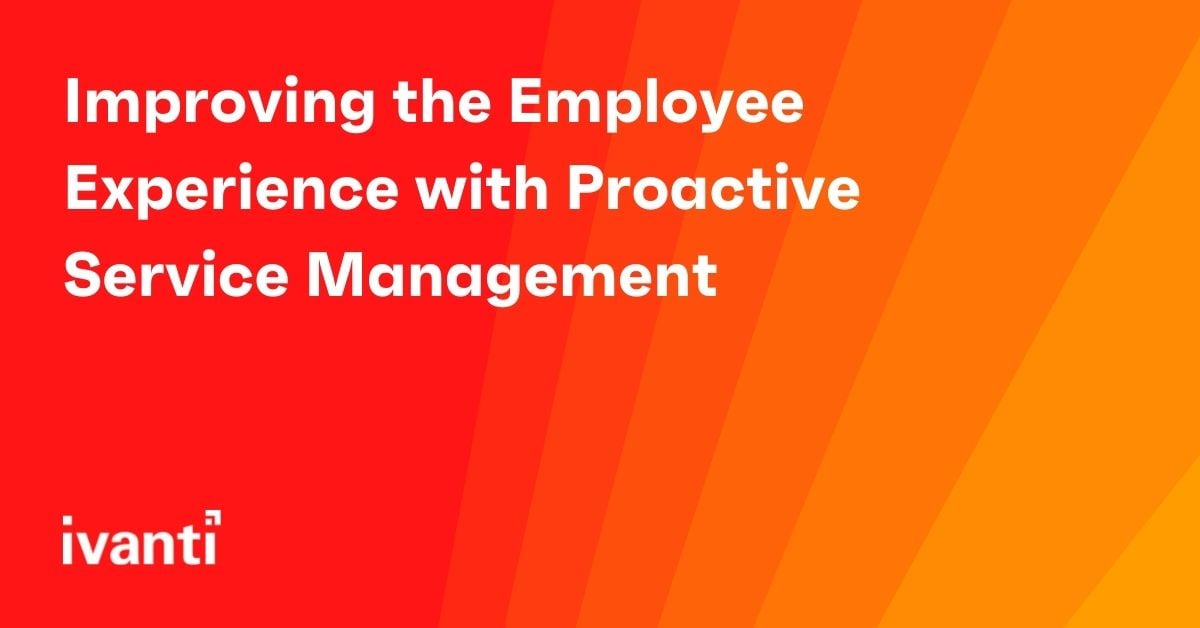Improving the Employee Experience with Proactive Service Management
Recently I was thinking about the topic “How do you improve the employee experience?” Many organisations drive this from an IT perspective with concepts like a Self-Service Portal, or Teams Channels, chatbots, even Social IT boards. These are all great ideas, but are they truly addressing employee experience?
Let me elaborate on this concept. I have a friend who uses a Service Management solution that has a fantastic Self-Service Portal which allows them to create issues, search the knowledge base, and make service requests such as ordering a new computer. And, the two or three times he has used the Self-Service Portal and interacted with IT he has been happy.
Poor Employee Experience
But when I asked him what he thought of IT, he said they were never proactive, and he was always having issues with his computer. What? Why? Two weeks earlier, he caught the train into the city; the trip is about 1.5 hours and he had time to work, so out came his laptop and he started working. Thirty minutes later the laptop battery ran out of juice and he could not continue working. Three days later when he powered up his laptop, he received the message, “Your battery can no longer provide sufficient power to your system and needs to be replaced." Six months earlier he had issues with Blue Screen crashes and his motherboard. After the battery issue, he went to the self-service portal, created an issue with IT, who then told him the laptop needed to be replaced and to raise a service request for a replacement laptop.
Now IT were very quick in identifying what needed to be done and responding to my friend. Within the context of the issue, they did a good job. But my friend was still unhappy with IT. His first comment to me was why couldn’t they be proactive and know about these issues before he did.
I put a question back to him. If IT was proactive and could see these issues before you did, and even order you a replacement part, or order a new computer without you having to do that, how would you rate them? His comment was a simple 10 out 10. Excellent.
Shift Left
Many organisations talk about the concept of “Shift Left.” What this is trying to do is focus on service excellence and end user empowerment. By just empowering the end user, this only moves the process a very small amount to the left. The largest shift left is proactive identification and resolution of the issues.
Automation and Self-Healing
Let’s put this into action using Ivanti Neurons for Healing and see what the process can look like.
1. An automation process executes against a laptop and based on this process, identifies battery health as poor, terrible, or no longer useable.
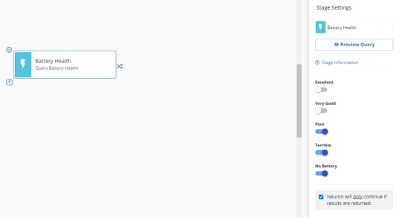
2. The results of this then sends a message to the laptop owner via Microsoft teams notifying them of this issue and asking what they would like to do:
- Notify IT of the issue
- Request a new laptop
- Ignore the issue for now
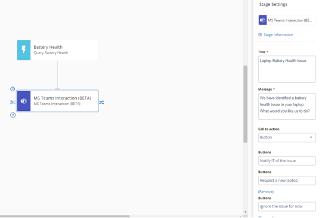
3. As a result of this Teams interaction, the automation process will either:
- Create a service request for a new laptop
- Notify IT of the issue
- Ignore the issue for a while longer
4. Now of course you could skip the Microsoft Teams interaction but having that notification capability keeps the user engaged and aware of what is happening, and proactively involved.
Putting this all together what does this automation process look like?
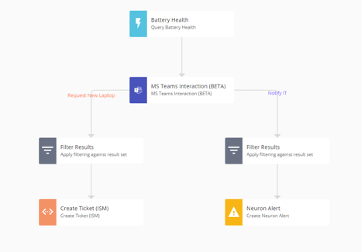
This shift left move enables the user to work without distraction and interruption. How many times do we as users Google how to fix something on our work laptop? Why? Because we feel we can get this resolved immediately ourselves, rather than having to logon to the self-service portal, log an issue, wait for an IT person to reply, and arrange a common time for the IT person to remote into your computer -- only to have them try the same things you have already tried and tell you what you already know.
Think about the different issues you have had recently, or maybe colleagues have had. Let’s list a few:
- Battery Health. We’ve already covered this one, but the reality is users don’t know about their battery health until they need a new battery, and sometimes that is during an important presentation.
- Print Spooler. One recent issue was a vulnerability you may have heard of was with the Windows 10 Print Spooler. Many IT organisations turned off the print spooler, and users found this out when they went to print. Imagine not being able to print that report you were about to give to the CIO.
- Blue Screen Crashes. How often do you immediately log an issue with IT when you get a blue screen crash? Typically, it would take three to five times before you say enough is enough. But if this happens automatically and, behind the scenes, the automation creates an IT Issue, they will be aware the first time.
- Application Crashes. Again, how quickly do you really get around to telling IT that the Application crashes? Often this one goes undetected until you are discussing this over the watercooler.
Now I have only listed four scenarios, and I am sure that you can list many more. There are so many trivial untold stories that often never get to IT. Imagine knowing about these issues before the employee raises it, and even better resolving it proactively. Ivanti Neurons for Healing comes with many predefined checks like the ones described above and also enables you to build your own.
A 360-degree view
Automation and Self-Healing are two key aspects of driving a better employee experience and another area to consider is having a 360-degree view of the employee. All Service Management platforms have data about an employee. They can tell you their name, email, phone, manager, location, building, the incidents and requests they have initiated, and even the assets they own. While this data is useful, it is static or historical data. How much better would it be if we could get a real time view about the user, the devices, and what is happening at that time: incidents logged, performance of the laptop, and other information.
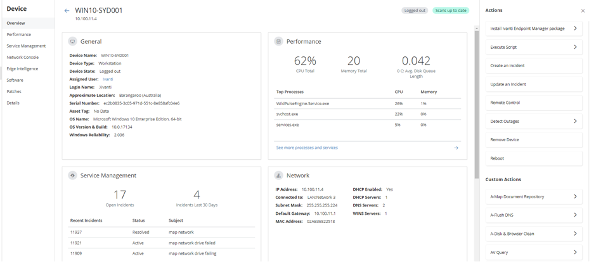
Ivanti Neurons Workspace enables you to view user device data as well as detailed information like performance, recent incidents logs, software, patches etc. This information gives an IT analyst in-depth and powerful real time information which they can use to quickly identify and remediate.
New Employee Experience
Finally, what if we could understand the real employee experience? In nearly all service management platforms, this is achieved via sending surveys in response to issues or requests. These are great as point-in-time views, but do not give a true holistic view of a user’s experience. As we discussed earlier, my friend was not happy with IT due to the issues he was having with his computer. If we could bring together all that information into one place and, using analytics, give a score across areas of an employee, then we could have an employee index that gives us the ultimate view of the employee.
At Ivanti we are putting the employee first, and through improving employee experience, we can empower everyone in the Everywhere Workplace. Ivanti Neurons for ITSM together with Neurons hyperautomation (Healing and Workspace) combine to enable proactive service models that makes for a better employee experience. Are you interested in learning more about how Ivanti can help you put your employees first? Reach out to us and we’ll be glad to help.
